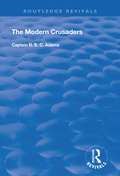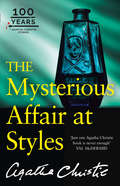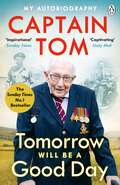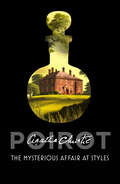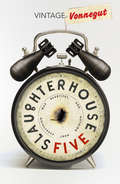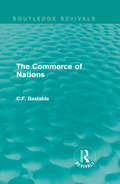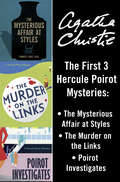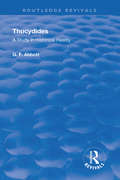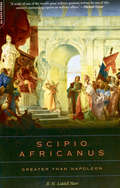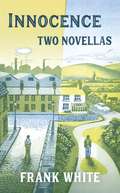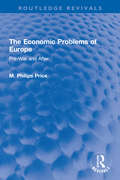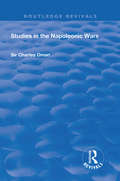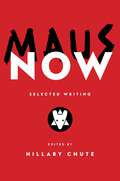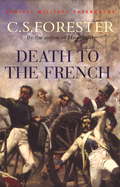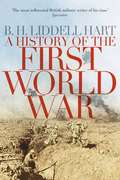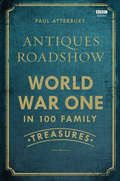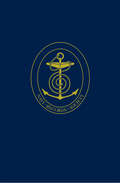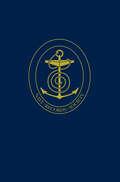- Table View
- List View
The Modern Crusaders (Routledge Revivals)
by R. E. AdamsOriginally published in 1920. The 231st Infantry Brigade, with which this diary is chiefly concerned, came into extence in January 1917, at a time when its compoent parts were engaged in the campaign against the Senussi, distributed in the Western Desert of Egypt and the Oases, from Sollum to Dakhala. The diary opens on October 1st 1917, when the preparations for the simultaneous attacks on Beersheba and Gaza were nearing completion.
The Modern Crusaders (Routledge Revivals)
by R. E. AdamsOriginally published in 1920. The 231st Infantry Brigade, with which this diary is chiefly concerned, came into extence in January 1917, at a time when its compoent parts were engaged in the campaign against the Senussi, distributed in the Western Desert of Egypt and the Oases, from Sollum to Dakhala. The diary opens on October 1st 1917, when the preparations for the simultaneous attacks on Beersheba and Gaza were nearing completion.
The Mysterious Affair at Styles: The First Hercule Poirot Mystery (Hercule Poirot Mystery Ser.)
by Agatha ChristieAgatha Christie’s first ever murder mystery. Includes an introduction by Christie archivist John Curran, and the original unpublished courtroom chapter as an alternate ending to the novel.
Tomorrow Will Be A Good Day: My Autobiography
by Captain Tom MooreEmbark on an enchanting journey into our country's past hundred years through the remarkable life of Captain Sir Tom Moore.'A wonderful life story with lessons for us all . . . beautifully written' DAILY TELEGRAPH'His upbeat nature shines through and reminds us how much worse this year would have been without him' EVENING STANDARDFrom his humble Yorkshire childhood, via the battlefields of Burma and the peaks of the Himalayas, to becoming the NHS and the nation's hero during Lockdown, this is a journey for all of us.__________ Who is Captain Sir Tom Moore? You've seen him on the television walking the length of his garden. A frail elderly man, doing his bit at a time of crisis. But he wasn't always like this.Where did he come from? Where was he made? From a childhood in the foothills of the Yorkshire Dales, Tom Moore grew up in a loving family, which wasn't without its share of tragedy. It was a time of plenty and of want. When the storm clouds of the Second World War threatened, he raised his hand and, like many of his generation, joined up to fight.His war would take him from a country he had never left to a place which would steal his heart, India, and the Far East, to which he would return many years later to view the sight he had missed first time around: the distant peak of Everest. Captain Tom's story is our story.It is the story of our past hundred years here in Britain.It's a time which has seen so much change, yet when so much has stayed the same: the national spirit, the can-do attitude, the belief in doing your best for others. In this rich, happy life packed with incident you will encounter time and again the curiosity, courage and generosity that saw Captain Tom look around him during our current crisis and decide that something had to be done . . .'Gloriously enthralling' Daily Mail
The Mysterious Affair at Styles: The First Hercule Poirot Mystery (Poirot)
by Agatha ChristieAgatha Christie’s first ever murder mystery.
Slaughterhouse 5: The Children's Crusade A Duty-Dance With Death
by Kurt VonnegutRead Kurt Vonnegut's powerful masterpiece, which is as timely now as when it was first published.‘An extraordinary success. A book to read and reread. He is a true artist’ New York Times Book ReviewBilly Pilgrim – hapless barber's assistant, successful optometrist, alien abductee, senile widower and soldier – has become unstuck in time. Hiding in the basement of a slaughterhouse in Dresden, with the city and its inhabitants burning above him, he finds himself a survivor of one of the most deadly and destructive battles of the Second World War. But when, exactly? How did he get here? And how does he get out?Travel through time and space on the shoulders of Vonnegut himself. This is a book about war. Listen to what he has to say: it is of the utmost urgency.‘The great, urgent, passionate American writer of our century, who offers us a model of the kind of compassionate thinking that might yet save us from ourselves.’ George Saunders
Routledge Revivals: The Commerce of Nations (1923)
by C.F. BastableFirst published in 1929, this book was written to express the belief that nations’ commercial policy and doctrines could best be explained by reference to their history. The author argues that this applies equally to legislation and theory, for example both the McKinley Act of 1890 and contemporaneous protectionism are examined as the culmination of a century’s worth of legislative and theoretical progress. This edition is also updated from the original 1891 publication to take account of the effect of the First World War on the European and American tariff systems, and also how the preferential system of trade within the British Empire recast relations between Britain and its dominions.
Routledge Revivals: The Commerce of Nations (1923)
by C.F. BastableFirst published in 1929, this book was written to express the belief that nations’ commercial policy and doctrines could best be explained by reference to their history. The author argues that this applies equally to legislation and theory, for example both the McKinley Act of 1890 and contemporaneous protectionism are examined as the culmination of a century’s worth of legislative and theoretical progress. This edition is also updated from the original 1891 publication to take account of the effect of the First World War on the European and American tariff systems, and also how the preferential system of trade within the British Empire recast relations between Britain and its dominions.
Hercule Poirot 3-Book Collection 1: Two Bestselling Mysteries
by Agatha ChristieThe first three Hercule Poirot books see the former Belgian policeman tempted out of retirement to solve a series of outlandish murders in Britain and France, assisted by the redoubtable Captain Hastings, setting him on the path to becoming the World's Greatest Detective!
Thucydides: A Study in Historical Reality (Routledge Revivals)
by G.F. AbbottFirst published in 1925, this thoughtful volume constitutes an excellent English introduction to one of the great ancient historians. Originating from its author’s re-reading of Thucydides during World War I, it sought to place Thucydides not as the production of a remote world, but instead of one instilled with present life and reality. Dealing especially well with Thucydides’ method as a historian, this volume focuses less on military aspects and more on Thucydides’ approach to foreign policy, democracy, imperialism and the struggle for power.
Thucydides: A Study in Historical Reality (Routledge Revivals)
by G.F. AbbottFirst published in 1925, this thoughtful volume constitutes an excellent English introduction to one of the great ancient historians. Originating from its author’s re-reading of Thucydides during World War I, it sought to place Thucydides not as the production of a remote world, but instead of one instilled with present life and reality. Dealing especially well with Thucydides’ method as a historian, this volume focuses less on military aspects and more on Thucydides’ approach to foreign policy, democracy, imperialism and the struggle for power.
Scipio Africanus: Greater Than Napoleon
by B.h. Liddell HartFrom one of the most brilliant military historians of our time, this is the classic biography of Rome's greatest general and the victor over Rome's greatest enemy, HannibalScipio Africanus (236-183 B.C.) was one of the most exciting and dynamic leaders in history. As commander, he never lost a battle. Yet it is his adversary, Hannibal, who has lived on in public memory.As B.H. Liddell Hart writes,"Scipio's battles are richer in stratagems and ruses--many still feasible today--than those of any other commander in history." Any military enthusiast or historian will find this to be an absorbing, gripping portrait.
Innocence: two novellas
by Frank WhiteIn 2017 Hodder published Frank White's There Was A Time, surely the last novel about the Second World War to be written by someone who actually served in it. Now at the age of 93, Frank has written a poignant, nostalgic novella of coming of age in a Yorkshire village in the sixties and it is paired with another short novel set in Manchester at the outbreak of war and first published by Hodder in 1964. Innocence and A Morse Code Set are beautifully complementary in theme and show Frank White to be an author of extraordinary insight and tenderness.
The Economic Problems of Europe: Pre-War and After (Routledge Revivals)
by M. Philips PriceFirst Published in 1928 The Economic Problems of Europe presents a comprehensive overview of the economic and political transformation of Europe since the First World War. European and world problems often tend to be looked upon from the political, diplomatic, naval, or military aspect. Morgan Philips Price attempted to add the economic background and to show the connection between the political rearrangements since the First World War and the material needs of society, markets of the industrialist, the wages of the workman, and the loans of the bankers. He argued that with the growing internationalization of the world economy, the old map of the world is obsolete and the new one, if it is based on frontiers of finance and industry, will be something very different. This book is an essential read for scholars and researchers of economic history, war history, political economy, British economic history and European history.
The Economic Problems of Europe: Pre-War and After (Routledge Revivals)
by M. Philips PriceFirst Published in 1928 The Economic Problems of Europe presents a comprehensive overview of the economic and political transformation of Europe since the First World War. European and world problems often tend to be looked upon from the political, diplomatic, naval, or military aspect. Morgan Philips Price attempted to add the economic background and to show the connection between the political rearrangements since the First World War and the material needs of society, markets of the industrialist, the wages of the workman, and the loans of the bankers. He argued that with the growing internationalization of the world economy, the old map of the world is obsolete and the new one, if it is based on frontiers of finance and industry, will be something very different. This book is an essential read for scholars and researchers of economic history, war history, political economy, British economic history and European history.
Revival: Studies in the Napoleonic Wars (Routledge Revivals)
by Charles OmanThis book presents a general summary of the views on the history of the world held by various historians’ perspective. Rest of the book is derived from author’s main work of 20 years on the Napoleonic period. Narrative includes four stories of the Secret Service that illustrate in different fashions the underworld of political and military intrigue which escapes notice in other general history work. Some of the material included in this book is derived from the study of the British tactics before the Peninsular War and helps to comprehend Duke of Wellington’s methods of warfare with Napoleon and his armies. Discussion is included on Napoleon’s system of using his cavalry as a generalization with a specific study of the handling of the cavalry by his generals in the Spanish War.
Revival: Studies in the Napoleonic Wars (Routledge Revivals)
by Charles OmanThis book presents a general summary of the views on the history of the world held by various historians’ perspective. Rest of the book is derived from author’s main work of 20 years on the Napoleonic period. Narrative includes four stories of the Secret Service that illustrate in different fashions the underworld of political and military intrigue which escapes notice in other general history work. Some of the material included in this book is derived from the study of the British tactics before the Peninsular War and helps to comprehend Duke of Wellington’s methods of warfare with Napoleon and his armies. Discussion is included on Napoleon’s system of using his cavalry as a generalization with a specific study of the handling of the cavalry by his generals in the Spanish War.
Maus Now: Selected Writing
by Art Spiegelman Hillary ChuteA richly illustrated book in which leading cultural critics, authors, and academics reflect on the radical achievement and innovation of Art Spiegelman's Pulitzer Prize-winning masterpiece Maus'The most affecting and successful narrative ever done about the Holocaust' Wall Street Journal___________________________________________________________________________It is hard to overstate Art Spiegelman's effect on postwar American culture. The Pulitzer Prize-winning author is one of our most influential contemporary artists, and his masterpiece Maus has shaped the fields of literature, history, and art. Collecting responses to the work that confirm its unique and terrain-shifting status, Maus Now is a new collection of essays that sees writers such as Philip Pullman, Robert Storr, Ruth Franklin, and others approaching the complexity of Maus from a wide range of viewpoints and traditions.Offering translations of important French, Hebrew, and German essays on Maus for the first time, this collection edited by American literary scholar Hillary Chute - an expert on comics and graphic narratives - assembles the world's best writing on this classic work of graphic testimony.___________________________________________________________________________'The first masterpiece in comic book history' The New Yorker on Maus'No summary can do justice to Spiegelman's narrative skill' Adam Gopnik on Maus'Like all great stories, it tells us more about ourselves than we could ever suspect' Philip Pullman on Maus
Death To The French (Sven Hassel War Classics)
by C. S. ForesterA stand-alone novel that inspired Bernard Cornwell's Sharpe seriesIt is 1810, and the last French invasion of Portugal has penned Wellington's army behind the river Tagus with their backs to the sea.Separated from his regiment, Rifleman Dodd of the Ninety-Fifth stumbles on a band of undisciplined Portuguese guerrillas. With rough inventiveness he transforms this ramshackle group into an organised fighting force, continually harrying the infuriated enemy as he battles his way back to his own lines.Written by the author of the Hornblower series, DEATH TO THE FRENCH is a classic novel of the Peninsular War, and was the inspiration for Bernard Cornwell's Sharpe books.
A History of the First World War
by B. H. Liddell HartLiddell Hart's History of the First World War first appeared in 1930 and is widely regarded as one of the greatest, most cogent accounts of the conflict ever published. A leading military strategist and historian who fought on the Western Front, Liddell Hart combines astute tactical analysis with compassion for those who lost their lives on the battlefield. He provides a vivid and fascinating picture of all the major campaigns, balancing documentary evidence with the testimony of personal witnesses to expose the mistakes that were made and why.From the political and cultural origins of war to the twists and turns of battle, to the critical decisions that resulted in such devastating losses and to the impact on modern nations, this magnificent history covers four brutal years in one volume and is a true military classic.
Antiques Roadshow: World War One In 100 Family Treasures
by Paul AtterburyTo mark the centenary of the start of World War I, the Antiques Roadshow team filmed a series of specials at the Somme, where the public brought in their family's war memorabilia and photographs. These 'antiques' weren't financially valuable, or in some cases even very beautiful, but the stories that came attached to these momentoes were priceless. Antiques Roadshow: World War I in 100 Family Treasures takes 100 of the most fascinating and moving stories and shows how they fit in to the wider history that was occuring around them. From Rifleman Frank Edwards, who led the 'big push' in September 1915 kicking a football in front of the troops (and survived to tell the tale) to the formidable Catherine Murray Roy, one of the first 50 nurses to be sent to the front lines in France. The story behind each object paints an intimate portrait of a long-lost relative, and quotes from the modern-day participants in the roadshow provide a moving link between the families then and now. Fully illustrated, and featuring all the stories from the show, this is a truly unique way of telling the story of those ordinary lives that were, by the onset of war in 1914, thrown into the most extraordinary of circumstances.
Evelyn Prentis Bundle: A Nurse in Time/A Nurse in Action
by Evelyn PrentisDesperate circumstances were something Evelyn Prentis had to get very used to when she began her life as a nurse. It was in 1934 that Evelyn left home for the first time to enrol as a trainee at a busy Nottingham hospital in the hope of £25 a year. A Nurse in Time is Evelyn's affectionate and funny account of those days of dedication and hardship, when never-ending nightshifts, strict Sisters and permanent hunger ruled life, and joy was to be found in a late-night pass and a packet of Woodbines.The second memoir in this collection is A Nurse in Action. Surprising Matron as well as herself, Evelyn Prentis managed to pass her Finals and become a staff-nurse. Encouraged, she took the brave leap of moving from Nottingham to London - brave not least because war was about to break. Not only did the nurses have to cope with stray bombs and influxes of patients from as far away Dunkirk, but there were also RAF men stationed nearby - which caused considerable entertainment and disappointment, and a good number of marriages ...But despite all the disruption to the hospital routine, Evelyn's warm and compelling account of a nurse in action, shows a nurse's life would always revolve around the comforting discomfort of porridge and rissoles, bandages and bedpans.
The Tangier Papers of Samuel Pepys
by W. Matthews Edwin ChappellIn 1683 Samuel Pepys accompanied George Legge, Lord Dartmouth, to Tangier as his secretary. During the voyage Pepys kept another brief diary and miscellaneous notes which contain valuable information about the navy. He recorded his concerns, as well as the views of the sea officers and others with him. Richard Leake, master gunner, was criticised by Pepys for not being able to hit the side of the target, and for not being able to get the charges correct to blow up the forts. He recorded that Captain David Lloyd, a sea officer, was also a painter with a good reputation.Pepys records his views about the merits of gentleman captains and their behaviour compared to ‘tarpaulin captains’. He also collected in these Papers every story he could, about the alleged immorality and corruptness of Arthur Herbert, the commander-in-chief of the English Mediterranean fleet, in order to discredit him with the king. Herbert had, in fact, returned to England before Pepys had arrived in Tangier. The source of the stories about Herbert’s behaviour, in the Tangier Papers, came from old friends of Pepys and Herbert’s enemies, and are not to be trusted, or accepted as a true account of what Herbert achieved; this can only be traced through Herbert’s own letters and the unpublished admiralty papers in the Public Record Office.
The Tangier Papers of Samuel Pepys
In 1683 Samuel Pepys accompanied George Legge, Lord Dartmouth, to Tangier as his secretary. During the voyage Pepys kept another brief diary and miscellaneous notes which contain valuable information about the navy. He recorded his concerns, as well as the views of the sea officers and others with him. Richard Leake, master gunner, was criticised by Pepys for not being able to hit the side of the target, and for not being able to get the charges correct to blow up the forts. He recorded that Captain David Lloyd, a sea officer, was also a painter with a good reputation.Pepys records his views about the merits of gentleman captains and their behaviour compared to ‘tarpaulin captains’. He also collected in these Papers every story he could, about the alleged immorality and corruptness of Arthur Herbert, the commander-in-chief of the English Mediterranean fleet, in order to discredit him with the king. Herbert had, in fact, returned to England before Pepys had arrived in Tangier. The source of the stories about Herbert’s behaviour, in the Tangier Papers, came from old friends of Pepys and Herbert’s enemies, and are not to be trusted, or accepted as a true account of what Herbert achieved; this can only be traced through Herbert’s own letters and the unpublished admiralty papers in the Public Record Office.
The Private Papers of John, Earl of Sandwich: 1771-1782, Vol. III
by G.R. Barnes J.H. OwenThe Fourth Earl of Sandwich was First Lord of the Admiralty (for the third time in his long career) from 1771 to 1782. Blamed by the Whig opposition for many of the disasters of the American War, he was additionally loaded by 19th-century Whig historians with the false image of a corrupt libertine.It was the publication of these volumes of his correspondence and papers (then in the family home, now in the National Maritime Museum), covering the years 1771 to 1782, which restored his reputation as a conscientious and imaginative naval administrator and reformer, especially of the dockyards and of the timber question. Without entirely rescuing his status as a strategist, they showed very clearly the weaknesses at the heart of the North administration which damaged its handling of the war, and undermined Sandwich’s efforts.A fifth volume intended to cover his handling of naval patronage was overtaken by the war.This volume is from May 1779 to December 1780.
